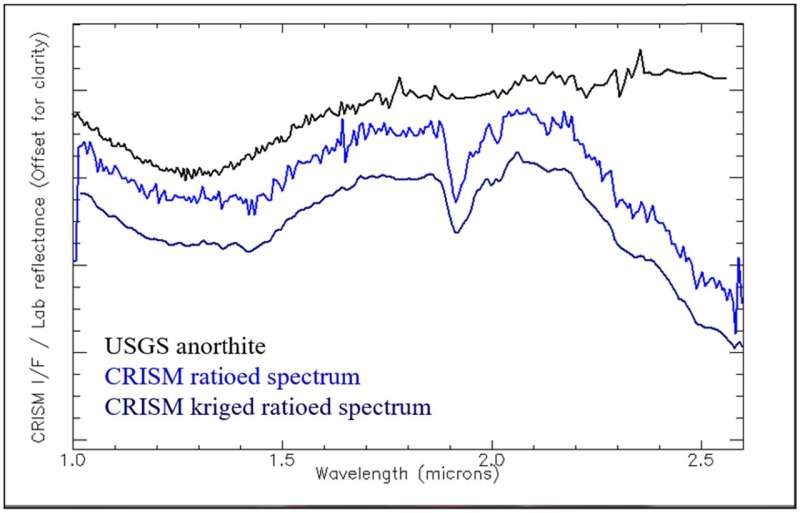Raw versus denoised spectra(kriged with mineral recognizer) of CRISM FRT000B8E2 are compared to the USGS anorthite HS201.3B reference spectrum. Credit: Geophysical Research Letters (2023). DOI: 10.1029/2022GL100772
A team of researchers at Université de Lorraine in France, working with a colleague from Brock University in Canada, and one each from Université Clermont Auvergne and Université Lyon, both in France, has found evidence of large deposits of plagioclase feldspar in the walls of Valles Marineris on Mars. In their study, published in the journal Geophysical Research Letters, the group used data from the Mars Reconnaissance Orbiter (MRO) to find the igneous rock and determine what the find might reveal about the history of the planet.
Plagioclase feldspar is formed from cooling magma or lava, which suggests the material in Valles Marineris originated from volcanic activity. Valles Marineris is a massive network of channels or gashes on the surface near the planet's equator. The network is approximately 4,000 kilometers long and current theory suggests it was formed by two tectonic plates pulling apart with subsequent erosion adding to its features.
Plagioclase feldspar is rarely seen on Mars, which makes the find all the more important. Prior to this new find, virtually all of it has been found deep below the Martian surface and has only been exposed by meteor impacts.
Data from the MRO showed a layer of the igneous rock approximately 2 meters thick extending for several kilometers. The researchers suggest its shape indicates that it was formed due to lava flowing onto the surface of the planet. They note that the layer they observed lies several kilometers beneath other rock, which also was likely formed by lava flows. Spectral analysis has thus far suggested it is mostly basalt.
The researchers note that plagioclase feldspar is actually a class of rock made up of minerals that are related to one another; thus, more study is required to determine the exact combination comprising the layer they observed in Valles Marineris. Learning its true makeup could help determine if the layer was made from flowing lava or ash that came from above. And figuring that out could help determine what types of rock makes up the Martian crust as a whole—to date, it is not yet known.
More information: Jessica Flahaut et al, New detections of feldspar‐bearing volcanic rocks in the walls of Valles Marineris, Mars, Geophysical Research Letters (2023). DOI: 10.1029/2022GL100772
Journal information: Geophysical Research Letters
© 2023 Science X Network
























